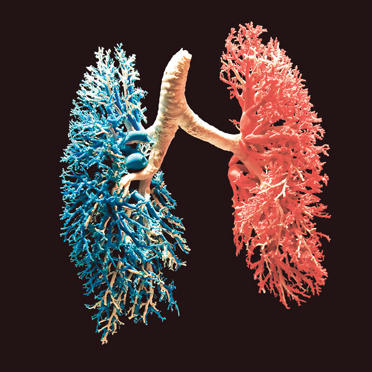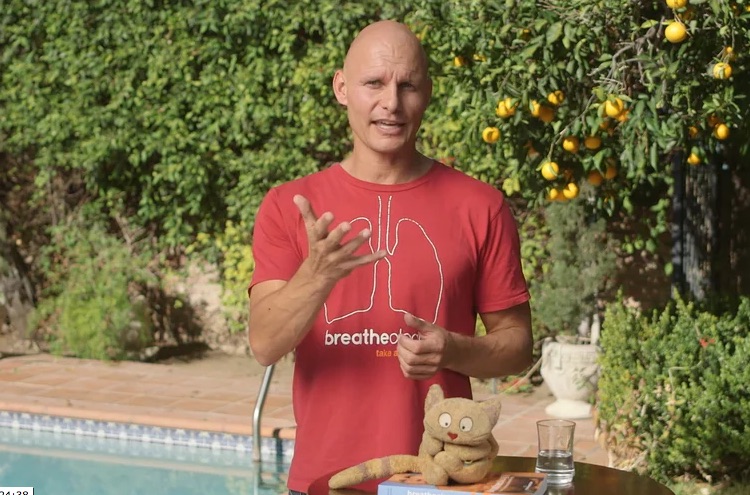Articles, Health & Rehabilitation
The Human Lungs
Breathing and flow in upper airways
Let us take a closer look at the movement of air to your lungs and the exchange of oxygen and carbon dioxide. If you close your eyes and take a couple of deep breaths, try to feel the air flow in your body. Where does air enter, where does it flow to, and how does it feel? There are two entry points for air: Air can enter through the nose or through the mouth. There are many good reasons for breathing through your nose including the fact that your blood is better oxygenated in the lungs. The mouth should only be used for eating and talking. 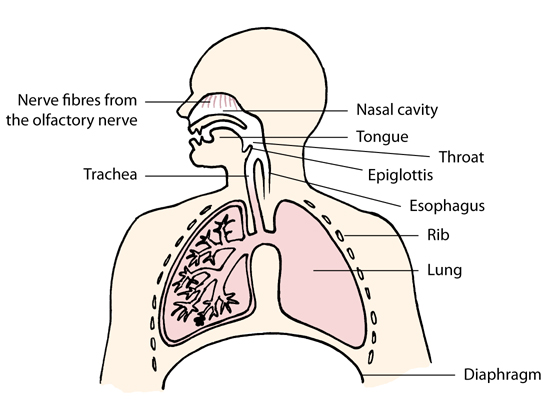 When air enters your nose, the many small hairs in your nose immediately filter out larger particles. Air then proceeds to the nasal conchae where it is humidified and warmed, and at the same time, smaller particles are filtered out by the surrounding mucous membranes. Indeed if we use our nose properly, we will be able to appreciate this extremely sensitive organ. The entire nasal cavity receives nerve fibers from the nervous system, and thus directly influences our health and state of mind. In the upper part of the nose there is a number of delicate sensory cells that can detect various smells and odors, and the information from these are directed via nerve fibers to the brain.
When air enters your nose, the many small hairs in your nose immediately filter out larger particles. Air then proceeds to the nasal conchae where it is humidified and warmed, and at the same time, smaller particles are filtered out by the surrounding mucous membranes. Indeed if we use our nose properly, we will be able to appreciate this extremely sensitive organ. The entire nasal cavity receives nerve fibers from the nervous system, and thus directly influences our health and state of mind. In the upper part of the nose there is a number of delicate sensory cells that can detect various smells and odors, and the information from these are directed via nerve fibers to the brain.
Deep down into the lungs
When air leaves the nose, it continues past the hindmost parts of the oral cavity’s roof where the uvula is. Further down in the throat it passes the epiglottis, which is a little flap of cartilage tissue behind the tongue. If you are in doubt where your epiglottis is, try swallowing while feeling your throat. Also try breathing at the same time – is it possible? When you breathe, the epiglottis stands in an upright position, but it closes the entrance to your trachea to protect the lungs as soon as you swallow. In this way solid food and liquid is passed to the stomach without entering our trachea and lungs.
How we talk, sing and produce sounds
Not many people realize that without air we would not be able to speak, shout or sing. The larynx, which is our “voicebox” is situated immediately below the epiglottis. It consists of two vocal chords and various cartilaginous parts. When the vocal chords are pulled together and air is passed from the lungs, they vibrate and produce sound. It is an impressive precision of mechanics at work when the vocal cords produce this wealth of various sounds in speech or in song. The area between the vocal cords is called the glottis, and when it is completely closed, air cannot pass to or from the lungs. Accordingly, the vocal chords not only function in sound production but can also protect the lungs by closing.
Our beautiful lungs
En route to the lungs, air flows down through the trachea, which branches at the bottom to form an upturned Y. Air flows through the two thick branches called bronchi to the left and right lung. The lungs look like two conical sponge-like sacs that almost fill up the chest cavity. The largest is the right lung and is subdivided in to three lobes. The left lung consists of two lobes and has a cardiac impression to give room for the heart. Many imagine that the lungs are simply two bags that can shrink and expand. The lungs are in fact exceptional and beautifully branched structures reminiscent of large unruly corals.

Gas-exchange from lung to bloodstream
The bronchi further divide into smaller branches (bronchioles) that are situated within the lungs. From here air finally reaches its destination, the alveoli (alveolus in singular), which are small air sacs resembling small grape-like clusters. It is in these small air sacs that blood and air exchange oxygen and carbon dioxide, and the alveoli are extremely specialized to perform this particular task.
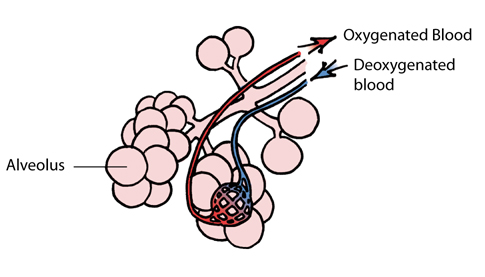
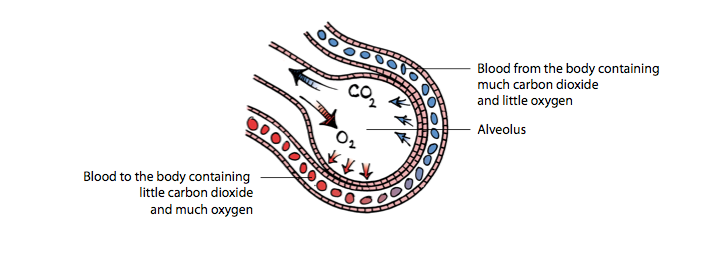
Firstly, the cell wall of the alveoli is very thin in some places, merely a few layers of cells corresponding to less than a thousandth of a millimeter. Oxygen moves freely to the many small blood vessels (capillaries) that surround each alveolus. This is also true for carbon dioxide which moves in the opposite direction – from the blood stream to the alveoli. In addition, oxygen is dissolved in a soap-like liquid that covers the inside of the alveoli and enhances oxygen flow. This liquid also supports the alveolus so that it does not collapse when the lungs are emptied, and keeps the alveolus optimally dilated and in close contact with the blood stream.
The effectiveness of the alveoli is also due to there being so many of them. There are roughly 300 million alveoli which correspond to a surface area of about 150 m2 (or about the size of a big house).
If you liked this article you are most welcome to share it with your friends…
Free Course to Improve Your Breathing
The FREE Breathing Discovery Class
Explore your own true breathing (and breath holding!) potential.
Follow the simple exercises and feel the immediate shift in your mind and effect on your body and soul.
It covers three lessons about benefits of conscious breathing, and how it will benefit your health and relax your mind.
Read more[thrive_2step id='2696']
Join the Free Masterclass
[/thrive_2step]
